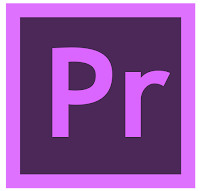 In our most recent lesson in the TV Studio, we were introduced to the Editing Suite. We learnt how to use the main editing software used for sequences at Hurtwood, called Adobe Premiere.
In our most recent lesson in the TV Studio, we were introduced to the Editing Suite. We learnt how to use the main editing software used for sequences at Hurtwood, called Adobe Premiere.
File Transport
Once we opened a new project in Premiere, you have to import all the relevant clips from the shoot and sort them into folders called "bins". These raw video files are traditionally called the "Rushes" (from the times when the reels had to be ran to the processing room so they could be viewed by the directing staff in order to see what went well/bad and what more was needed after the days shooting) and you can see them in the bottom left of the screenshot below.
Cutting/Pasting Clips
When viewing each clip in the library (in the top left window of the screenshot above), you play through until you find the "last frame in" and the "first frame out". Once you have found the frame of entrance with the yellow scroller, you press "i" on the keyboard to trim the start to that position. Then scroll through to the last frame of exit and press "o" to trim the clip end to that point. Then you click and drag that trimmed clip in to the arrangement area of the software (the bottom right). You place your first clip into video track 1 and audio track 1. Repeat this process with your next clip and drag and drop it into AV tracks 2. When you press play, the software automatically plays the clip that's on the highest track. So when track 2 overlaps track 1, it changes from 1 to 2, as you can see in the screenshot below. The clips are overlapped above and above.
Repeat this step with every shot you want to include while keeping an eye out for the audio, trimming it (or letting it play on entirely) with each trim of a clip.
Gradually, we started to build up our sequence using all the different shots we had from the week before. This included several wide shots, a mid shot, and several close ups, as well as a horizontal tracking shot for the footsteps. We were also notified of how important it was to constantly save our work in order to back up the progress we had made in case the computer crashed or there was a power cut. We had named ours with a unique and relevant name including our initials and project name. Finally, after making some final touches to the flow of the sequence, we checked for continuity, watched it in full a final time, and saved our finished sequence.
Easy.
Cutting/Pasting Clips
When viewing each clip in the library (in the top left window of the screenshot above), you play through until you find the "last frame in" and the "first frame out". Once you have found the frame of entrance with the yellow scroller, you press "i" on the keyboard to trim the start to that position. Then scroll through to the last frame of exit and press "o" to trim the clip end to that point. Then you click and drag that trimmed clip in to the arrangement area of the software (the bottom right). You place your first clip into video track 1 and audio track 1. Repeat this process with your next clip and drag and drop it into AV tracks 2. When you press play, the software automatically plays the clip that's on the highest track. So when track 2 overlaps track 1, it changes from 1 to 2, as you can see in the screenshot below. The clips are overlapped above and above.
Repeat this step with every shot you want to include while keeping an eye out for the audio, trimming it (or letting it play on entirely) with each trim of a clip.
Gradually, we started to build up our sequence using all the different shots we had from the week before. This included several wide shots, a mid shot, and several close ups, as well as a horizontal tracking shot for the footsteps. We were also notified of how important it was to constantly save our work in order to back up the progress we had made in case the computer crashed or there was a power cut. We had named ours with a unique and relevant name including our initials and project name. Finally, after making some final touches to the flow of the sequence, we checked for continuity, watched it in full a final time, and saved our finished sequence.
Easy.



No comments:
Post a Comment